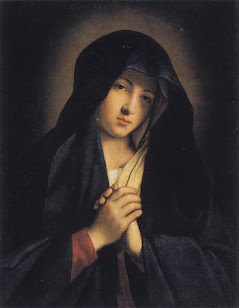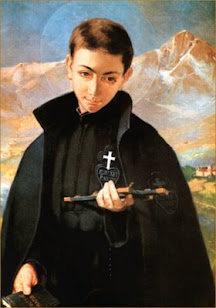Today, June 22, we celebrate the feast day of Saint Paulinus of Nola (354-431), bishop, Confessor, writer, and inspiration to many—including six great saint of the Church who referenced him in letters of encouragement to others: Augustine, Jerome, Melania, Martin or Tours, Gregory and Ambrose. Saint Paulinus is an example of the Holy Spirit working through men, and the beautiful art and poetry that can result. From the General Audience of Pope Benedict XVI, we read how Saint Paulinus put his art and poetry in service to the Church, enlivening the community of the faithful, and reflecting the beauty of the mysteries of our faith.
St. Paulinus of Nola is the Father of the Church to whom we turn today. A contemporary of St. Augustine, to whom he was bound by deep friendship, Paulinus exercised his ministry in Campania, in Nola, where he was first priest then bishop. He originally came from Aquitaine in the south of France, from Bordeaux, where he was born to a high-ranking family. He received a fine literary education, his teacher being the poet Ausonius.
The first time he left his homeland was to follow his precocious political career, which saw him rise at a young age to the post of governor of Campania. In this public office he showed his gifts of wisdom and moderation.
It was in that period that the seed of conversion was planted in his heart. The stimulus came from the simple yet intense faith with which people honored the grave of a saint, Felix the martyr, in the shrine of what is now Cimitile. As the person in charge of the public good, Paulinus took an interest in the shrine. He built a home for the poor and a road to give easier access for the numerous pilgrims.
While he was striving to build the earthly town, he was slowly discovering the way to the celestial one. The encounter with Christ was the arrival point of a laborious work, a work filled with trials. Painful circumstances, such as his being less favored by the political authorities, made him realize firsthand how transient things are. Once he came to the faith he will write: "Man without Christ is but dust and shadow" ("Carmen" X, 289).
Longing to make sense of existence he went to Milan to join Ambrose's school. He then completed the Christian education in his homeland, where he was baptized by Bishop Delphinus of Bordeaux. His marriage played a role in his path toward faith. He married Therasia, a devout noblewoman from Barcelona, with whom he had a son. He would have continued his life as a good Christian layman, had it not been for the death of his child, only a few days old, which shook him, showing him that God had a different plan for his life. He was called to devote himself to Christ in a strict ascetic life.
In full agreement with his wife Therasia, he sold his assets for the benefit of the poor, and left Aquitaine with her to go to Nola, where the two spouses took up residence next to the basilica of the patron St. Felix, living in chaste fraternity according to a way of life which others soon joined.
The community rhythm was typically monastic; Paulinus, who had been ordained a priest in Barcelona, committed himself to minister to the pilgrims. In this way he gained the trust of the Christian community that chose him as the successor to the chair of Nola after the death of its bishop around 409. His pastoral action intensified, characterized by a special attention toward the poor.
He left behind the image of an authentic pastor of charity, as St. Gregory the Great described him in Chapter III of his "Dialogues," where the heroic gesture of Paulinus offering himself as a prisoner in the place of a widow's son is illustrated.
The episode has been historically questioned; however, we are left with the image of a kindhearted bishop who stayed close to his people during the troubled times of the barbaric invasions.
Paulinus' conversion impressed his contemporaries. His teacher Ausonius, a pagan poet, felt "betrayed," and addressed him with harsh words, reproaching him on one hand for his "scorn" of material assets, which he found foolish, and on the other hand the fact that he abandoned his literary vocation. Paulinus replied that giving to the poor did not mean he despised earthly assets; on the contrary, he gave them a higher value by using them for charitable ends.
As to the literary engagements, Paulinus did not abandon the poetic talent, which he would still cultivate, but rather the poetic forms inspired by mythology and pagan ideals. A new aesthetic was driving his sensitivity: It was the beauty of God made man, crucified and resurrected, of whom he was now a poet. In truth he hadn't left poetry; now he took inspiration from the Gospel, as he says in the following verse: "To me faith is the only art, and Christ is my poetry" ("At nobis ars una fides, et musica Christus": "Carmen" XX, 32).
His poems are songs of faith and love in which the daily history of small and big events is seen as the history of salvation, the history of God with us. A lot of these compositions, the so-called Christmas Poems, are related to the annual festival of Felix the martyr, whom he had chosen as his heavenly patron. By remembering St. Felix he meant to praise Christ himself, convinced that it was thanks to the saint's mediation that he had obtained the glory of conversion: "In your light, oh joyous one, I loved Christ" ("Carmen" XXI, 373).
He wanted to express the same concept by enlarging the shrine with a new basilica, where the paintings, illustrated with subtitles, would become a visual catechesis for the pilgrims. That is how he explained his project in a "Carmen" dedicated to another catechist, St. Nicetas of Remesiana, while accompanying him during his visit to the basilicas: "Now I want you to contemplate the paintings on the walls of the decorated porticos. [...] We thought it would be helpful to use the painting to represent the sacred themes in St. Felix's house, in the hope that, by viewing these images, the painted picture will inspire interest in the astonished minds of the peasants" ("Carmen" XXVII, vv. 511.580-583). Today we can still admire the remains of such accomplishments, which place the saint from Nola among the main reference points of Christian archaeology.
In the ascetic community of Cimitile, life went on in poverty, prayer and fully immersed in the "lectio divina." Scripture -- read, pondered and assimilated -- was the light under which the saint from Nola scrutinized his soul in the drive toward perfection. To those who admired his decision to dispose of material assets, he reminded them that such gestures did not represent full conversion: "Abandoning or selling the assets we own in this world does not constitute the completion, but only the beginning of our race in the stadium; it is not, so to speak, the goal, but only the starting point. The athlete, in fact, does not win when he undresses, as he puts down his clothes to begin his fight; he is worthy of being crowned winner only after he has duly fought" (cf. Ep. XXIV, 7 to Sulpicius Severus).
Next to asceticism and the word of God lies charity: In the monastic community the poor were regulars. Paulinus did not only give alms: He welcomed the poor as if they were Christ himself. He had reserved for them an area of the monastery and, by doing so, he felt like not giving, but receiving, through an exchange of gifts between the offered shelter and the praying gratitude of the assisted ones. He called the poor his "patrons" (cf. Ep. XIII, 11 to Pammachio) and, because they lived in the lower floor, he liked to say that their prayer served as the foundation of his house (cf. "Carmen" XXI, 393-394).
St. Paulinus did not write theological treatises, but his poems and his dense epistolary are full of a lived theology, imbued with the word of God, constantly scrutinized like light for life. In particular, the sense of the Church as a mystery of unity emerges. He practiced communion above all through the practice of spiritual friendship. In this way, Paulinus was a true teacher, making of his life a crossroads of chosen souls: from Martin of Tours to Jerome, from Ambrose to Augustine, from Delphinus of Bordeaux to Nicetas of Remesiana, from Victricius of Rouen to Rufinus of Aquileia, from Pammachius to Severus Sulpicius, and many more, some more famous than others. The intense letters written to Augustine stem from this environment. Independent of the content of the individual letters, what's impressive is the warmth with which the saint from Nola celebrates friendship in itself, as a manifestation of the single body of Christ being animated by the Holy Spirit.
Here is a significant passage from the beginning of the correspondence between the two friends: "We should not be astonished if we, though distant, are in each other's presence and, without having met, we know each other, as we are parts of one body, we have one head only, we are filled with one grace, we live of the same bread, we walk along one single road, we live in the same house" (Ep. 6, 2).
As we can see, this is an amazing description of what it means to be a Christian, to be the Body of Christ, to live in communion with the Church. The theology of our times has found precisely in the concept of communion the key to approach the mystery of the Church. The testimony of St. Paulinus of Nola helps us to experience the Church as it is presented in the Second Vatican Council: sacrament of the intimate union with God, and as such the union of us all and eventually of all humankind (cf. "Lumen Gentium," No. 1).
Why pray the Rosary every day for a year?
Each time the Blessed Virgin has appeared-- whether it be to Saint Bernadette Soubirous at Lourdes; to Lucia, Jacinta, and Francisco at Fatima; or to Mariette Beco at Banneux-- she has asserted the importance, saving grace, and power of praying the Holy Rosary on a daily basis. Based upon her words, the Rosary is penance and conversion for sinners, a pathway to peace, an end to war, and a powerful act of faith in Jesus Christ. Pope Paul VI presented the Rosary as a powerful means to reach Christ "not merely with Mary but indeed, insofar as this is possible to us, in the same way as Mary, who is certainly the one who thought about Him more than anyone else has ever done."
To show us how this is done, perhaps no one has been more eloquent than the great Cardinal Newman, who wrote: "The great power of the Rosary consists in the fact that it translates the Creed into Prayer. Of course, the Creed is already in a certain sense a prayer and a great act of homage towards God, but the Rosary brings us to meditate again on the great truth of His life and death, and brings this truth close to our hearts. Even Christians, although they know God, usually fear rather than love Him. The strength of the Rosary lies in the particular manner in which it considers these mysteries, since all our thinking about Christ is intertwined with the thought of His Mother, in the relations between Mother and Son; the Holy Family is presented to us, the home in which God lived His infinite love."
As Mary said at Fatima, "Jesus wants to use you to make Me known and loved. He wishes to establish the devotion to My Immaculate Heart throughout the world. I promise salvation to whoever embraces it; these souls will be dear to God, like flowers put by Me to adorn his throne."

Subscribe to:
Post Comments (Atom)






0 comments:
Post a Comment
Thanks for leaving a comment. If you wish to submit a prayer request, however, please do so above, using the "Contact" tab.